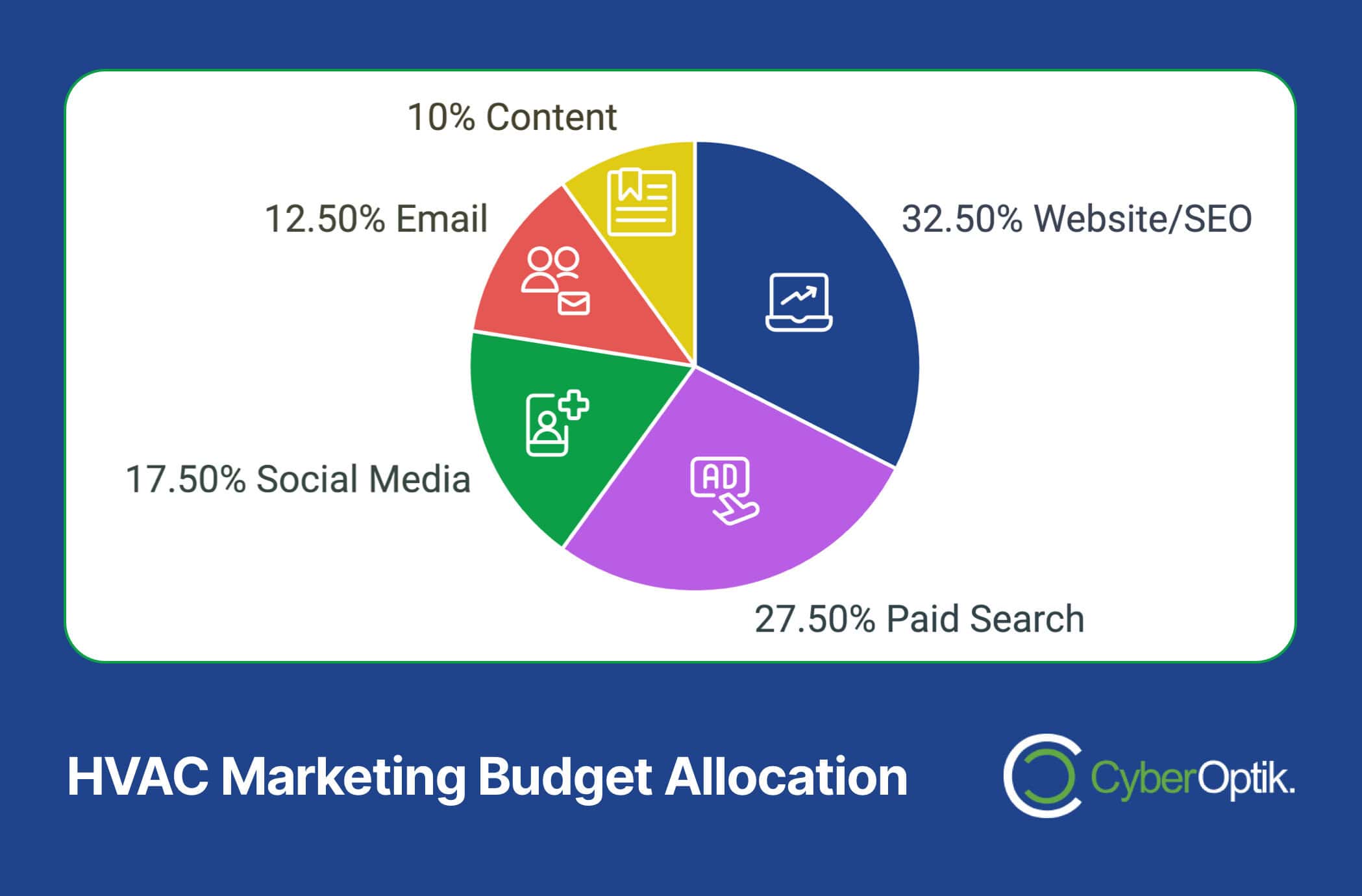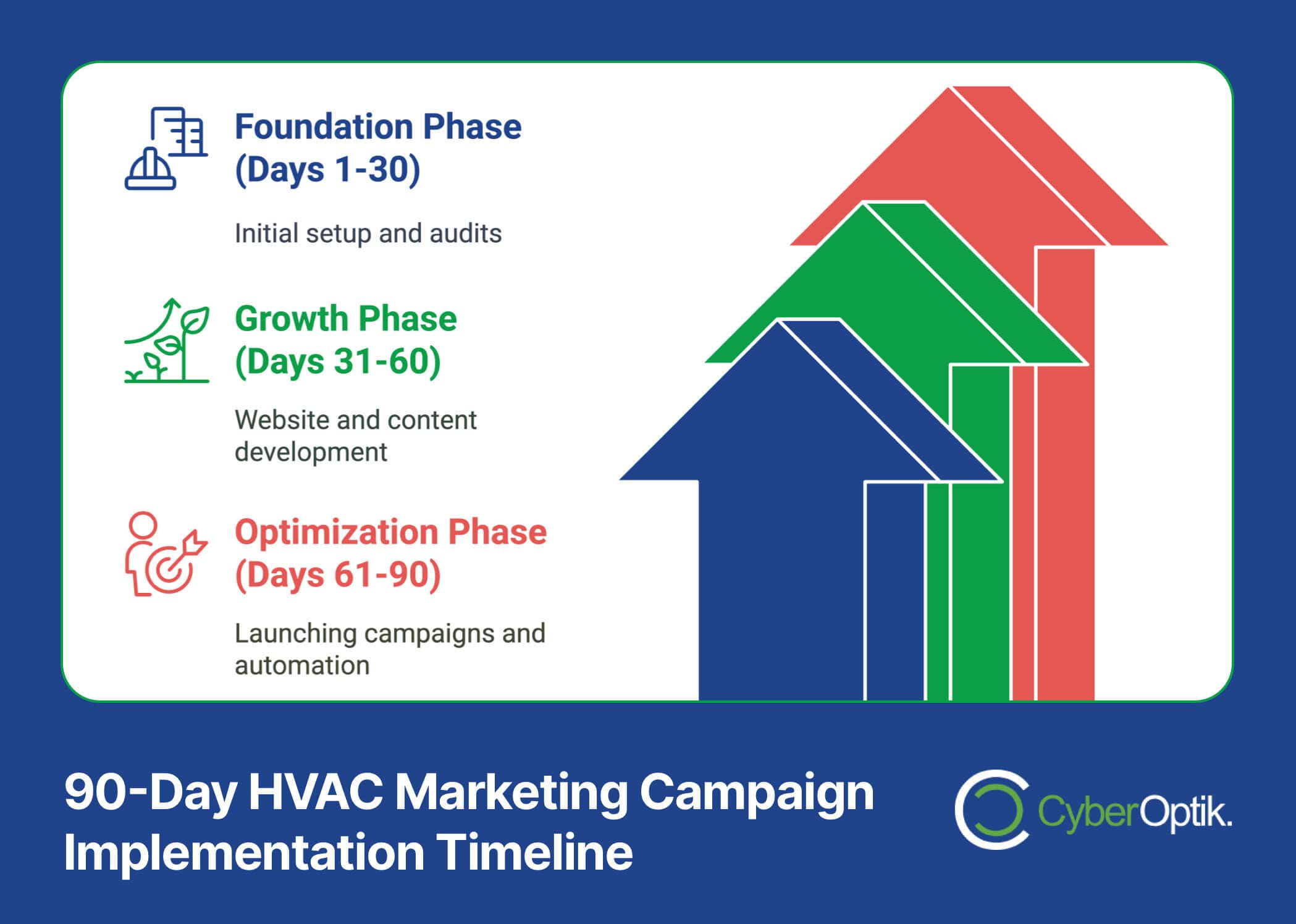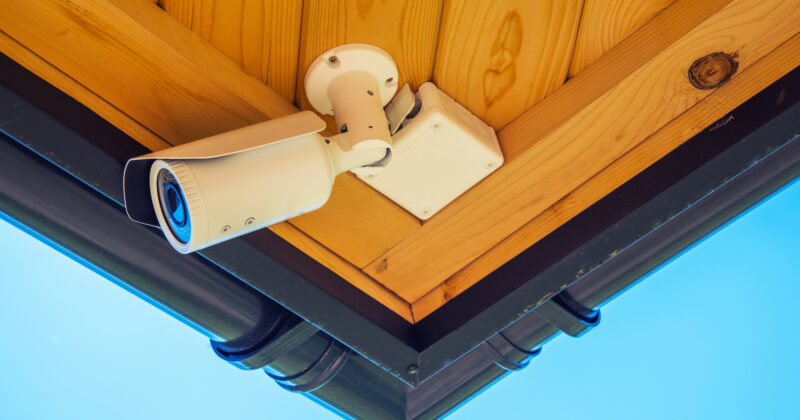Successful HVAC companies allocate 7-10% of their revenue to marketing, with 60-70% of that budget dedicated to digital channels (Source: 800.com).
We’ve developed this comprehensive digital marketing blueprint to help you maximize every dollar of your marketing investment in 2025.
The HVAC industry stands at a pivotal moment of digital transformation. With traditional marketing methods becoming less effective, your success depends on implementing a strategic digital approach that drives consistent leads and builds lasting customer relationships.
This blueprint combines proven digital strategies with emerging trends to create a roadmap for sustainable growth. We’ll show you exactly how to implement these strategies, measure their effectiveness, and adjust them for optimal performance in your specific market.
Understanding the 2025 HVAC Market Industry
The HVAC industry is experiencing unprecedented growth, with the global market projected to reach $296.92 billion by 2028 (Source: WebFX). This expansion creates both opportunities and challenges for HVAC companies looking to capture market share through digital channels.
We’re seeing significant shifts in how HVAC services are discovered and purchased. Digital-first consumer behavior means your online presence directly impacts your bottom line. Implementing effective local SEO strategies has become crucial for capturing high-intent searches in your service area.
Key Market Drivers Shaping Digital Strategy
Several factors are reshaping the HVAC marketing industry:
- Increasing demand for energy-efficient cooling solutions
- Smart technology integration and IoT connectivity
- Rising focus on preventative maintenance services
- Growing emphasis on indoor air quality solutions
These trends create new opportunities for digital content creation and targeted marketing campaigns. Your digital strategy must address these evolving consumer needs while maintaining visibility in your local market.
Digital Transformation Impact
The digital transformation in HVAC marketing goes beyond simply having a website. Modern consumers expect seamless online scheduling, instant quote capabilities, and responsive communication channels. This shift requires a comprehensive digital presence that integrates:
- Mobile-optimized website experience
- Online booking and service scheduling
- Digital payment processing
- Automated maintenance reminders
- Multi-channel customer support
Success in 2025 requires adapting to these digital expectations while maintaining the personal touch that builds lasting customer relationships. By understanding these market dynamics, you can position your HVAC company to capture a larger share of the growing digital marketplace.
Setting Your Digital Marketing Budget

With the U.S. commercial HVAC market expected to reach $112 million by 2032 (Source: HVAC Today), strategic budget allocation becomes crucial for capturing market share. We’ve developed a framework that helps HVAC companies implement proven promotional strategies while maximizing return on investment.
Budget Allocation Framework
| Marketing Channel | Percentage of Digital Budget | Primary Focus |
|---|---|---|
| Website & SEO | 30-35% | Foundation for digital presence |
| Paid Search | 25-30% | Immediate lead generation |
| Social Media | 15-20% | Brand awareness & engagement |
| Email Marketing | 10-15% | Customer retention & nurturing |
Investment Prioritization
Your digital marketing investment should focus on three core areas:
- Foundation Building: Website optimization, local SEO, and content development
- Lead Generation: Paid search, social media advertising, and retargeting campaigns
- Customer Retention: Email marketing, customer portal development, and automated communication systems
ROI Tracking Framework
Implementing proper tracking mechanisms ensures every marketing dollar generates measurable returns. Key metrics to monitor include:
- Cost per lead by channel
- Customer acquisition cost
- Lifetime customer value
- Return on ad spend (ROAS)
- Conversion rates by campaign
By structuring your budget around these frameworks and consistently measuring performance, you can optimize your marketing spend for maximum impact. This approach allows for agile adjustments based on real-time data while maintaining focus on long-term growth objectives.
Core Digital Marketing Channels for HVAC Success
Digital marketing success in the HVAC industry requires a multi-channel approach that meets customers where they’re actively searching for services. Recent data shows that Gen Z, an emerging customer demographic, particularly values authentic content and real-world applications in service-based marketing (Source: Optic Marketing Group).
Website Optimization and Local SEO
Your website serves as the foundation of your digital presence. We’ve identified these critical elements for HVAC website success:
- Mobile-first design with quick loading times
- Clear service area pages with location-specific content
- Emergency service booking functionality
- Customer portal integration
- Trust signals (licenses, certifications, reviews)
Local SEO optimization requires focusing on:
- Google Business Profile optimization
- Location-specific landing pages
- Local citation building and management
- Review generation and management
- Schema markup implementation
Paid Advertising Strategies
Strategic paid advertising drives immediate visibility and leads. Your paid marketing mix should include:
| Ad Platform | Primary Use | Target Audience |
|---|---|---|
| Google Search Ads | Emergency services | Immediate need customers |
| Local Service Ads | Service area targeting | Local customers |
| Facebook Ads | Maintenance promotions | Homeowners |
| Display Retargeting | Brand awareness | Website visitors |
Social Media and Content Marketing
Effective social media marketing for HVAC companies focuses on education and trust-building. Key content types include:
- Maintenance tips and tutorials
- Behind-the-scenes service footage
- Customer success stories
- Seasonal preparation guides
- Emergency troubleshooting advice
Platform-specific strategies should align with user behavior:
- Facebook: Community engagement and service promotions
- Instagram: Visual content and service team highlights
- YouTube: Educational content and maintenance tutorials
- LinkedIn: Commercial HVAC insights and company updates
Success across these channels requires consistent messaging while adapting content format and tone to each platform’s unique characteristics. By integrating these channels into a cohesive strategy, you create multiple touchpoints for customer engagement while building a strong digital presence.
Customer Engagement and Retention
Targeted email campaigns consistently prove effective for driving customer loyalty and repeat business in the HVAC industry. We’ve developed a comprehensive approach to customer engagement that builds lasting relationships while maximizing lifetime value.
Email Marketing Excellence
Your email marketing strategy should focus on these key campaign types:
- Seasonal maintenance reminders
- Service confirmation and follow-ups
- Equipment age-based replacement recommendations
- Energy efficiency tips and updates
- Exclusive customer promotions
Customer Feedback Systems
Implementing a structured feedback system helps identify areas for improvement while building trust. Essential elements include:
| Feedback Type | Timing | Action Items |
|---|---|---|
| Post-Service Survey | 24 hours after service | Service quality assessment |
| Review Requests | 48 hours after positive survey | Online reputation building |
| Satisfaction Check-In | 30 days post-installation | Long-term satisfaction |
| Annual Review | Yearly anniversary | Relationship strengthening |
Loyalty Program Structure
A well-designed loyalty program encourages repeat business and referrals. Key components should include:
- Priority scheduling for program members
- Annual maintenance discounts
- Referral rewards system
- Emergency service benefits
- Equipment upgrade credits
Automated Communication Framework
Implement these automated touchpoints to maintain consistent engagement:
- Equipment warranty expiration alerts
- Maintenance schedule reminders
- Filter replacement notifications
- Seasonal efficiency tips
- Birthday and anniversary acknowledgments
Success in customer retention comes from creating a seamless experience that anticipates customer needs while providing value at every interaction. By implementing these engagement strategies, you build a loyal customer base that generates consistent revenue through repeat business and referrals.
Seasonal Marketing Planning
With the HVAC industry growing at a CAGR of 9.7% through 2025 (Source: 800.com), capturing seasonal opportunities becomes crucial for sustainable growth. We’ve developed a strategic approach to seasonal marketing that maximizes revenue throughout the year.
Quarterly Marketing Focus
| Season | Primary Focus | Key Campaigns |
|---|---|---|
| Spring (Q1) | AC Preparation | Early-bird maintenance specials |
| Summer (Q2) | Emergency Services | 24/7 response guarantees |
| Fall (Q3) | Heating System Checks | Winter readiness packages |
| Winter (Q4) | Energy Efficiency | System upgrade promotions |
Pre-Season Campaign Elements
- Early booking incentives
- Preventive maintenance packages
- System efficiency assessments
- Equipment upgrade promotions
- Service agreement renewals
Peak Season Strategies
During high-demand periods, focus on these key elements:
- Emergency service visibility
- Rapid response guarantees
- Priority customer programs
- Capacity management messaging
- Strategic pricing adjustments
Off-Season Revenue Generation
Maintain steady business during slower periods through:
- Preventive maintenance promotions
- System upgrade incentives
- Indoor air quality services
- Extended warranty offerings
- Service agreement sales
Success in seasonal marketing requires proactive planning and precise timing. By aligning your marketing activities with seasonal demand patterns, you create a consistent flow of business while maximizing revenue during peak periods. This approach helps maintain steady growth while building long-term customer relationships through proactive service offerings.
Measuring Success and ROI
With the residential HVAC market showing an 8.1% CAGR (Source: WebFX), tracking your marketing performance becomes essential for capturing market share. We’ve developed a comprehensive framework for measuring and optimizing your digital marketing ROI.
Key Performance Indicators (KPIs)
| Metric Category | Key Metrics | Target Benchmarks |
|---|---|---|
| Lead Generation | - Cost per lead - Lead conversion rate - Lead quality score | Monthly improvement |
| Website Performance | - Conversion rate - Bounce rate - Page load time | Industry average +20% |
| Customer Acquisition | - Customer acquisition cost - Closing ratio - Revenue per customer | Quarterly optimization |
| Customer Retention | - Repeat service rate - Referral rate - Customer lifetime value | Year-over-year growth |
Analytics Tools and Implementation
Essential tools for tracking marketing performance include:
- Google Analytics 4 for website performance
- Call tracking software for lead attribution
- CRM system for customer journey tracking
- Social media analytics for engagement metrics
- Email marketing analytics for campaign performance
Performance Review Framework
Implement these review cycles for optimal performance monitoring:
- Daily Monitoring: Lead volume and quality
- Weekly Analysis: Campaign performance and adjustments
- Monthly Review: Channel performance and budget allocation
- Quarterly Assessment: Strategic planning and major optimizations
- Annual Evaluation: Overall strategy and market position
Optimization Strategy
Use this data-driven approach for continuous improvement:
- A/B testing of ad copy and landing pages
- Geographic performance analysis
- Service offering optimization
- Budget reallocation based on ROAS
- Customer journey optimization
Success in digital marketing requires constant measurement and optimization. By implementing these tracking systems and regularly analyzing performance data, you can make informed decisions that improve marketing efficiency and drive better returns on your marketing investment.
Implementation Timeline
With the industrial HVAC market projected to grow by $6.80 billion by 2029 (Source: 800.com), implementing your digital marketing strategy promptly becomes crucial. We’ve developed a 90-day action plan to help you capitalize on this growth opportunity.
30-Day Foundation Phase
| Week | Priority Tasks | Key Deliverables |
|---|---|---|
| Week 1-2 | Digital Audit & Planning | - Website assessment - Competitor analysis - Channel strategy documentation |
| Week 3-4 | Technical Setup | - Analytics implementation - Tracking setup - Tool integration |
60-Day Growth Phase
Focus on these key implementation areas:
Website Optimization
- Mobile responsiveness improvements
- Service page optimization
- Lead capture implementation
Content Development
- Service area content creation
- Blog post calendar
- Social media content bank

90-Day Optimization Phase
Implement advanced marketing elements:
Campaign Launch
- PPC campaign activation
- Social media advertising
- Email marketing sequences
Automation Setup
- Lead nurturing workflows
- Customer communication sequences
- Review generation system
Resource Allocation
| Resource Type | Allocation Priority | Implementation Timeline |
|---|---|---|
| Internal Team | Content creation & customer service | Immediate |
| Technology | CRM & automation tools | First 30 days |
| External Partners | Technical SEO & PPC management | 60-90 days |
Success in implementing this digital marketing blueprint requires dedication to the timeline while maintaining flexibility for market-specific adjustments. By following this structured approach, you’ll build a strong digital presence while creating systems for sustainable growth.
Frequently Asked Questions About HVAC Marketing
Based on our experience helping HVAC companies develop their digital presence, here are answers to the most common questions about implementing a digital marketing strategy.
What is the minimum marketing budget for an HVAC company?
The recommended marketing budget for HVAC companies starts at 7-10% of annual revenue, with 60-70% allocated to digital channels. However, companies can begin with a focused strategy targeting one or two primary channels, such as local SEO and Google Ads, then expand as they see returns on their investment.
How long does it take to see results from digital marketing?
While paid advertising can generate leads immediately, organic marketing efforts typically show meaningful results within 3-6 months. SEO and content marketing require consistent effort but deliver long-term sustainable results. The key is maintaining consistency while regularly measuring and optimizing performance.
Which digital marketing channel provides the best ROI for HVAC companies?
Local SEO combined with Google Ads typically provides the highest ROI for HVAC companies. This combination ensures visibility when customers actively search for HVAC services in your area. However, the most effective channel mix depends on your specific market conditions and business goals.
How can small HVAC companies compete with larger competitors online?
Small HVAC companies can effectively compete by:
- Focusing on specific service areas or niches
- Building a strong local presence
- Leveraging customer reviews and testimonials
- Creating targeted, location-specific content
- Providing superior customer service and communication
What are the most common digital marketing mistakes HVAC companies make?
Common pitfalls to avoid include:
- Neglecting mobile website optimization
- Inconsistent NAP (Name, Address, Phone) information
- Failing to track marketing performance
- Ignoring customer reviews and feedback
- Underinvesting in digital presence
How should seasonal marketing budgets be allocated?
Allocate marketing budgets based on your peak seasons, typically increasing spend 30-45 days before high-demand periods. Maintain a base level of marketing activity year-round while adjusting channel mix and messaging to align with seasonal demands and opportunities.
Ready to Transform Your HVAC Company’s Digital Presence?
Implementing a comprehensive digital marketing strategy requires expertise, resources, and consistent execution. Our team specializes in helping HVAC companies build and optimize their digital presence for sustainable growth.
Take the first step toward digital marketing success:
- Schedule a free digital marketing assessment
- Get a customized growth strategy for your HVAC company
- Start generating more qualified leads
Contact us today to learn how we can help your HVAC company thrive in the digital landscape.




